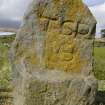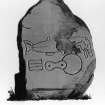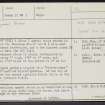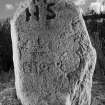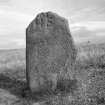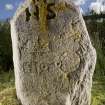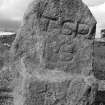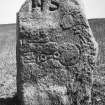Upper Manbean
Pictish Symbol Stone (Pictish)
Site Name Upper Manbean
Classification Pictish Symbol Stone (Pictish)
Alternative Name(s) Upper Manbeen; Field Of The Standing Stone
Canmore ID 16078
Site Number NJ15NE 7
NGR NJ 1868 5761
Datum OSGB36 - NGR
Permalink http://canmore.org.uk/site/16078
- Council Moray
- Parish Elgin
- Former Region Grampian
- Former District Moray
- Former County Morayshire
Upper Manbean, Moray, Pictish symbol stone
Measurements: H 0.91m above ground, W 0.60m, D max 0.36m
Stone type: gneiss
Place of discovery: NJ 1868 5761
Present location: still in situ.
Evidence for discovery: found standing in a field on the farm of Upper Manbean.
Present condition: weathered.
Description
The irregular face of this slab is incised with a serpent above a possible fish-monster, with below them a double-sided comb and a mirror with double-ball handle. In more recent times the initials M H S have been carved at the top, and on the back of the slab the initials T S P over other carvings.
Date: seventh century
References: ECMS pt 3, 128-9. Fraser 2008, no 164.
Desk-based information compiled by A Ritchie 2018
(NJ 1868 5761) A Class I symbol stone stands in the 'Field of the Standing Stone' about 1/4 mile west of Upper Manbeen farm-house, and a few hundred yards NE of the Butter Well (NJ 185 574). The gneissose stone is nearly rectangular in shape, measuring 3' high, 1'9" to 2' wide, and tapering from 1'2" thick at the bottom to 7" at the top.
The incised symbols consist of a 'fish-monster' with below it 'comb' and 'mirror' symbols. At the top of the stone are the recent initials M.H.S. while on the back are the initials T.S.P.
J R Allen and J Anderson 1903.
Field Visit (23 September 1943)
Symbol Stone, Upper Manteen.
This stone measures 3ft 5in in height, 2ft 2in in breadth and 1ft 4in in thickness at the base, but only 6in higher up as the upper part of the E face has been split off. It stands about 150yds W of the farm house on the slope to the small burn that flows past Auchtertyre to Miltonduff. It faces E and W. On a prepared surface on the W face are engraved the fish, the comb and the mirror symbols, the former above the two latter. Most of the body of the fish has scaled away but its tail and fins and the other symbols are fairly clear. Some marks in front of the place where the fish's head should be seem to be really irregularities in the rock.
Above the symbols, which are deeply patinated, the letters M/HS are deeply and rather rudely incosed; on on the E face of the stone T.S.P. which what may be an S below.
N.B. To bring out the carvings this stone should be photographed shortly after full noon about the equinox when the sun is just beginning to shine on the W face. By 2pm (GMT) on the autumn equinox the lighting was already too square to bring out fully the shallow but rather wide lines (Cf. ECM iii, pp128f).
Visited by RCAHMS (VGC, AG) 23 September 1943.
Field Visit (4 August 1965)
This weathered symbol stone is as described above, except that the stone width does not taper, but has a definite ledge on the reverse face. Surveyed at 1/2500.
Visited by OS (N K B) 4 August 1965.
Field Visit (4 October 1976)
No change since report of 4 August 1965.
Surveyed at 1:2500.
Visited by OS (J B) 4 October 1976.
Reference (1997)
Class I symbol stone bearing a fish monster above a mirror-and-comb.
A Mack 1997 p.103
External Reference (3 August 2002)
Dr B Henery has pointed out that the head and undulating body of a serpent, not previously noted, are visible between the incised lettering and the 'fish-monster'. The serpent runs horizontally across the stone, with its head, which is shown as seen from above, facing towards the dexter side of the stone. The outline of the head appears on Stuart's plate (1856, pl.xvii), and the head and body are discernable on photographs by RCAHMS (A36869), T E Gray (B82886/po), and A Mack (B80639/po). The serpent does not appear in Allen and Anderson's sketch (1903, 129), but this is clearly in error in a number of other respects. Most significantly Allen and Anderson show the 'fish-monster' to be complete, whereas Stuart's plate indicates that flaking of the surface between the tail and the head had already taken place.
Information from letter (NMRS MS/1134) from Dr B Henery, 3 August 2002.
Note (6 August 2002)
From the above it is possible that the 'fish-monster' illustrated by Allen and Anderson (1903, 129), may actually be comprised of two separate symbols: the fish or salmon and a wolf-like beast's head.
Information from RCAHMS (IFr), 6 August 2002.
















